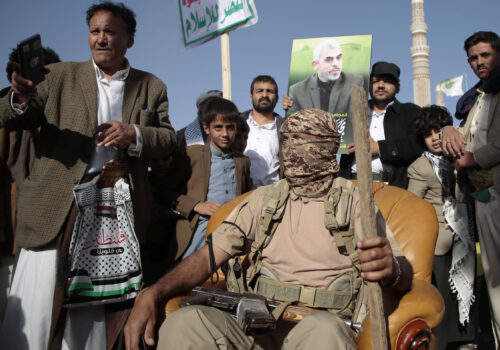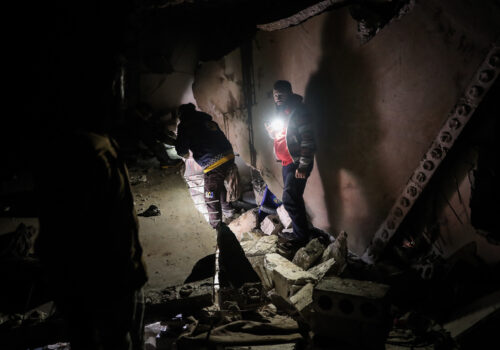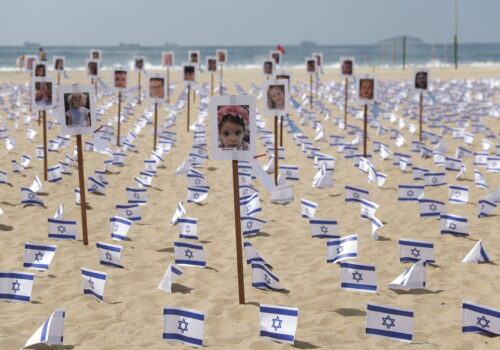War, peace, or a perpetual state of crisis—three possible paths for the Middle East’s future
The Middle East remains a focal point of global security concerns and is marked by intricate alliances, ideological confrontation, and strategic rivalries that have kept the region in a near-constant state of tension. The ongoing debate between escalation and de-escalation reveals the complexity of the region’s geopolitics and the different perspectives on future conflicts.
While some analysts foresee an inevitable escalation that could lead to a larger regional war, others believe that the incentives for de-escalation are strong enough to prevent such a catastrophe. A third perspective, however, suggests that the region might persist in a protracted state of low-intensity conflict without a clear resolution.
The argument for escalation: the only way out is through
Proponents of escalation argue that a large-scale conflict in the Middle East is increasingly likely, given the current trajectory of regional tensions. These analysts point to the ongoing friction between Israel, Iran, and their respective allies, which has manifested in a series of targeted attacks, drone strikes, and missile exchanges across Lebanon, Syria, and Iraq—particularly since the October 7, 2023, Hamas assault on Israel.
SIGN UP FOR THIS WEEK IN THE MIDEAST NEWSLETTER
There is a persistent pattern of violence in the Middle East that can rapidly lead to multifront confrontations. This cyclical escalation often follows a pattern of provocation, retaliation, and further military mobilization, with each response heightening the risk of a broader conflict that could spiral out of control. Should these conflicts spread, the repercussions extend beyond immediate borders, potentially disrupting trade routes critical to the global economy, destabilizing financial markets, and creating conditions conducive to terrorism.
The escalation took on a new dimension after October 7, which resulted in significant Israeli casualties and triggered a powerful military reprisal. This escalation reignited concerns of a larger-scale conflict involving neighboring countries or proxy forces as Israel and Hamas engage in a brutal cycle of retaliation. Israel’s traditional approach toward its adversaries has long emphasized preemptive strikes and the targeted elimination of hostile leaders, a strategy designed to neutralize threats before they materialize into direct confrontations. Israel has increasingly resorted to heavy-handed military escalations, particularly in the Gaza Strip and Lebanon. These tactics include airstrikes and artillery barrages aimed at diminishing the capabilities of groups such as Hamas and Hezbollah.
Non-state actors such as Hezbollah in Lebanon, Hamas in Gaza, and the Houthis in Yemen add complexity to the already volatile regional environment. These groups, often supported by regional powers, hold significant autonomy and frequently act according to their interests, which might not always align with those of their state sponsors. The Houthis, for example, receive Iranian support but pursue objectives that align with their local grievances and aspirations for control in Yemen. These groups are often unpredictable, taking actions that provoke retaliation and draw in their sponsors, even when state actors prefer to avoid direct confrontation.
Escalation in the Middle East does not follow a step-by-step process but is marked by retaliatory actions. Each retaliation reflects strategic calculations to signal strength while avoiding outright war. The timing of a retaliation is also important. Immediate responses often signal urgency and resolve, while delayed responses indicate patience or a desire for more time to plan.
The cycle of escalation is also impacted by external actors, such as the United States and Russia, who influence the decisions of regional players. The United States has taken significant steps to influence the circumstances in the Middle East by pressuring Qatar to expel Hamas leaders based in Doha. This action follows failed attempts to negotiate a ceasefire and hostage release between Hamas and Israel, an outcome the United States has prioritized under President Joe Biden’s administration. US officials have urged Qatar to use the threat of expulsion as leverage in these negotiations, seeing expulsion as a way to limit Hamas’s operational freedom and international legitimacy.
Critics of the escalation argument note that predictions of full-scale war often represent worst-case scenarios shaped by pundits, journalists, and analysts. Media amplify these doom-and-gloom prognostications, which then fuel public anxiety and create the impression that war is inevitable. This focus on escalation obscures the behind-the-scenes de-escalatory diplomacy that often prevents crises from reaching their most extreme outcomes. The reality of a “full-scale” war in today’s Middle East is rarely presented. Most likely, such a war would not involve country fighting against country but would pit a complex web of state actors, paramilitary groups, ideological militias, and transnational organizations against each other in irregular warfare across multiple borders without a clear beginning or end.
Moving beyond zero-sum politics: de-escalation in motion
Recent diplomatic efforts illustrate the potential for regional stability as a viable alternative to military confrontation. The China-brokered normalization agreement between Saudi Arabia and Iran in March 2023 underscored a shift toward mutual respect and resolving sectarian differences, helping to stabilize the Gulf region. The 2020 Abraham Accords similarly signaled a transformative approach to Middle Eastern diplomacy, promoting peace agreements between Israel and several Arab nations. These initiatives, however, required a high degree of commitment and cooperation from regional and global powers.
The United Arab Emirates’ (UAE) diplomatic engagement with Iran in 2022 and Turkey in July 2023 further exemplified how Gulf states are moving beyond zero-sum politics toward a more pragmatic approach to security and cooperation. Rather than treating Iran and Turkey solely as adversaries, the UAE has pursued dialogue and trade partnerships, seeking to address security concerns through diplomacy. This shift toward engagement over hostility aligns with other regional efforts, including the reintegration of Syria into the Arab League.
Economic pressures also serve as a powerful moderating influence, particularly for nations facing internal financial challenges that limit their capacity to sustain prolonged conflicts. For example, Iran’s economy has been severely weakened by years of sanctions, affecting its ability to fund proxy groups and invest in extended military operations. Full-scale conflict would exacerbate these economic pressures, with potential repercussions for domestic stability, as prolonged military spending could lead to further inflation, shortages, and public discontent.
Advocates of de-escalation emphasize that while tensions are undeniably high, the stakes for full-scale war are too costly. They argue that regional actors have economic, humanitarian, and political reasons to avoid an all-out conflict, as seen in past crises in which brinkmanship led to ceasefires rather than open war. Furthermore, proponents of de-escalation believe that military posturing often serves as a deterrent rather than an immediate prelude to war. For instance, although Iran continues to develop its missile capabilities, these moves could be intended to signal strength rather than to instigate conflict. Actors manage escalation by carefully selecting targets and limiting physical damage. This was seen in Iran’s warnings before a recent retaliatory missile attack, which allowed Israel to prepare its defenses and avoid significant casualties, thereby reducing escalation risks.
De-escalation in the Middle East is not simply the inverse of escalation; it is a complex process shaped by both intended and unintended factors. Efforts to de-escalate are frequently challenged by the involved parties, each of whom have distinct agendas and varying degrees of control over local factions.
Some skeptics point out that de-escalation is sometimes employed as a tactical measure rather than a long-term commitment to peace. Regional powers might reduce hostilities in one area to buy time or respond to diplomatic pressure while planning for future operations elsewhere. The US approach to Middle East diplomacy often involves encouraging de-escalation in specific areas while maintaining broader strategic interests. This dual approach, exemplified by the Biden administration’s push for Israeli-Palestinian negotiations while simultaneously strengthening military ties with Israel, allows for tactical de-escalation while maintaining influence in the region.
Arguments for de-escalation often fail to address the web of interrelated conflicts in the region. A framework that accounts for this complexity is needed to achieve lasting peace. De-escalation efforts tend to involve only a subset of the region’s actors, leaving the broader context of Middle Eastern conflicts unresolved. These initiatives, such as ceasefires and truces, provide short-term relief but can be swiftly undone by new provocations or shifting alliances, which can reignite tensions and return the region to a state of instability.
The same-as-it-ever-was perspective: regional conflict remains but doesn’t boil over
Beyond the binary perspectives of escalation and de-escalation lies a third perspective that argues that the political and ideological disputes that continue to fuel tensions in the Middle East are entrenched. Proponents of this view do not foresee a full-scale war in the region nor lasting peace but, rather, a continuation of proxy battles, sporadic clashes, and diplomatic brinkmanship without a decisive resolution.
This third perspective is supported by ongoing proxy conflicts, such as the intermittent skirmishes between Iranian-backed militias and US-aligned forces in Iraq. While these incidents have yet to lead to direct conflict between Iran and the United States, they reflect a pattern of sustained low-level violence, which keeps the conflict simmering without reaching a boiling point. Another example is the prolonged Israeli-Palestinian conflict, in which neither side has achieved a decisive victory, but escalations and ceasefires have become a recurring cycle.
This perspective also accounts for the possibility of unexpected factors that could either defuse or aggravate tensions, such as shifts in US foreign policy, domestic upheavals within Iran, or sudden changes in leadership. While these factors do not guarantee de-escalation, they create conditions in which traditional models of escalation or de-escalation may no longer apply, reinforcing the notion of a sustained, yet manageable, level of conflict.
Kristian Alexander is a senior fellow and lead researcher at the Rabdan Security and Defense Institute (RSDI) in the United Arab Emirates.
Further reading
Mon, Nov 25, 2024
Sinwar is dead, but Hamas finally got its victory
MENASource By
The rebranding of Yahya Sinwar’s death as “heroic martyrdom,” combined with the humanitarian catastrophe in Gaza, has paved the way for Hamas to evolve into an even more extreme and dangerous entity.
Thu, Nov 7, 2024
Managing counterterrorism foreign liaison relationships in an increasingly competitive world
MENASource By
Robust investment in foreign liaison relationships enables the fundamental conditions required for an effective global counterterrorism strategy, and not just within the countries where these partnerships are enabled.
Fri, Oct 4, 2024
One year after Hamas’s October 7 terrorist attacks, here’s how the region has changed
MENASource By
One year on, the Gaza War remains unresolved and the potential for war across the region is becoming more likely. Atlantic Council experts take on questions about the war's impact—and its future.
Image: Residents of Beirut southern suburb, wave the flags of pro-Iranian Hezbollah as they jubilate while return to the devastated party stronghold. A ceasefire between Israel and the Lebanese Hezbollah militia came into force in the early hours of 27 November, but it was preceded by heavy explosions in the Beirut area right up until the ceasefire start time. via Reuters


